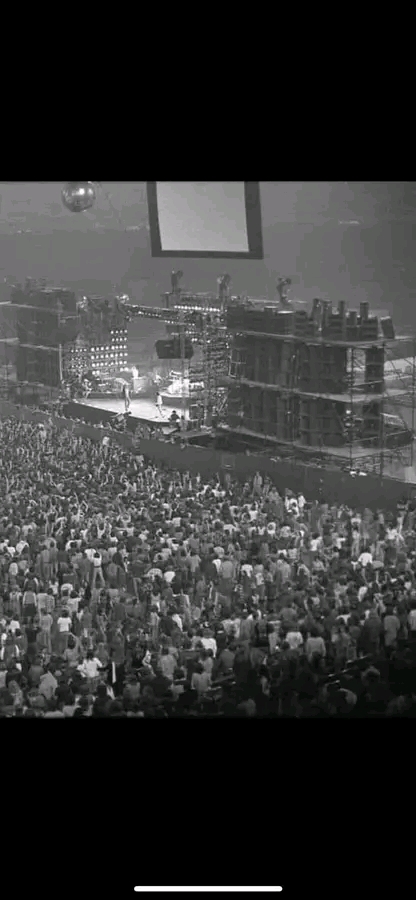Led Zeppelin’s reputation as one of the greatest and most influential rock bands in history is firmly rooted in their legendary live performances, characterized by explosive energy, technical prowess, and an unrelenting commitment to delivering an unforgettable auditory experience. Their concerts became the stuff of legend, not only because of their groundbreaking music but also due to the sheer volume and intensity of their sound. The band’s use of massive stacks of Marshall amplifiers, often stacked in towering configurations, created a wall of sound that enveloped the audience, leaving a lasting impact that has echoed through the annals of rock history.
From their early days, Led Zeppelin’s approach to live performance was about more than just playing songs — it was about creating an immersive sonic assault that pushed the boundaries of what was technically possible at the time. Their performances were often longer than studio recordings, with extended improvisations, instrumental solos, and variations that kept audiences on the edge of their seats. This willingness to stretch and evolve their songs in live settings became a hallmark of their shows, making each concert a unique event.
One of the most notorious aspects of Led Zeppelin’s live shows was their volume. The band believed that loud music was essential to conveying the raw power and emotion of their songs. They often played at levels that many would find ear-shattering. For example, during a 1969 performance, they delivered a rendition of “Heartbreaker” that is said to have reached an astonishing 130 decibels. To put that into perspective, 130 dB is comparable to standing right behind a Boeing 747 jet engine as it takes off. Such a level is not only deafening but also capable of causing immediate and permanent hearing damage if proper precautions are not taken.
This audacious approach to volume was part of Led Zeppelin’s ethos — they prioritized the visceral impact of their music over comfort or safety. Their goal was to create a sound that was so powerful that it could physically move the audience, a feat they achieved time and again. The sheer force of their live sound was a testament to their technical skill and their desire to push the limits of rock performance.
The iconic image of Led Zeppelin’s live shows often includes massive stacks of Marshall amplifiers. These towering configurations, sometimes comprising dozens of individual units, produced an enormous amount of power. The amplifiers were cranked to maximum, resulting in a distorted, thunderous sound that became a signature of their performances. This setup not only boosted their volume but also contributed to the distinctive tonal character of their music—rich, full-bodied, and fiercely raw.
One of the most memorable moments in Led Zeppelin’s concert history took place at the Pontiac Silverdome in 1977. The band played in front of a massive crowd, and the show is often remembered for its scale and intensity. During that performance, the band’s sound levels were so high that they reportedly caused a seismic effect — the vibrations from the music were strong enough to shake the building and be felt by the audience. The Silverdome, with its enormous capacity and vast indoor space, served as the perfect venue for such a colossal display of power.
Despite the awe-inspiring nature of their volume and intensity, Led Zeppelin’s concerts also showcased their musicianship and artistic creativity. Jimmy Page’s guitar work, Robert Plant’s soaring vocals, John Paul Jones’s versatile bass and keyboard playing, and John Bonham’s thunderous drumming all combined to create a dynamic and compelling live experience. Their extended improvisations and variations kept each show fresh, and their ability to sustain such high-volume performances without sacrificing musicality was remarkable.
However, their famously loud performances did come with some consequences. Audience members and even band members often experienced temporary hearing issues after concerts. The intense volume could cause ringing ears and, over time, contributed to hearing loss for some. This was a risk that Led Zeppelin was willing to accept in their pursuit of creating a visceral, immersive experience. It also reflected the era’s different attitudes toward hearing safety, which, at the time, was less emphasized than it is today.
In addition to their sonic intensity, Led Zeppelin’s live shows were known for their theatricality and raw energy. They often played with a sense of spontaneity, improvising solos and interactions that made each concert special. Their sound was so loud and powerful that it created a sense of chaos and excitement, drawing audiences into a shared experience of musical adrenaline.
The legacy of Led Zeppelin’s live performances continues to influence musicians and concert producers today. Their mastery of volume, extended improvisations, and ambitious amplification setups set new standards for what a rock concert could be. They demonstrated that live music could be a force of nature, capable of overwhelming the senses and leaving a profound impression on those lucky enough to witness it.
In conclusion, Led Zeppelin’s legendary live shows were characterized by their explosive sound, massive stacks of Marshall amplifiers, and a willingness to push the limits of volume and performance. Their 1969 rendition of “Heartbreaker” reaching 130 decibels exemplifies their approach — a bold, uncompromising pursuit of sonic power. The 1977 Pontiac Silverdome concert stands as a testament to their ability to create a monumental auditory experience that shook the very foundations of the venue. These performances not only cemented their place in rock history but also demonstrated the transformative power of live music — a force capable of moving and inspiring audiences in ways that words alone cannot express.


